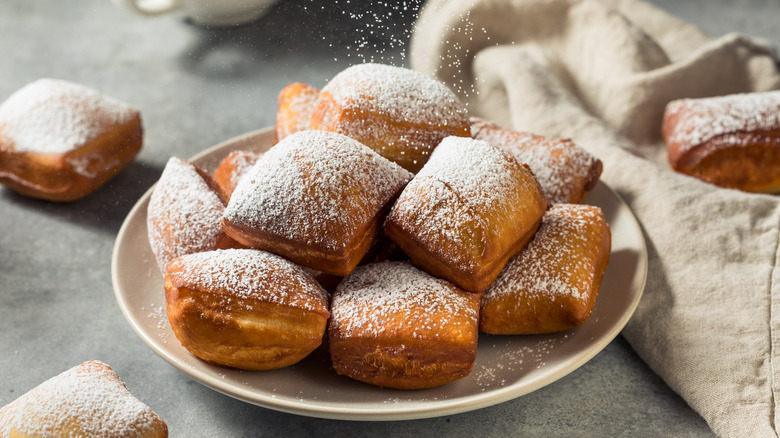Nina Compton's Top Tips For Making Beignets At Home
One of the airiest, most ethereal fried dough treats is the beignet, a French import that has found a happy home in the Big Easy. People flock to New Orleans to, among other things, grab a cup of chicory coffee and a plate of sugar-dusted beignets at Café du Monde, and an enterprising few attempt to recreate these sweet treats at home, which may seem easier said than done. But don't worry; Tasting Table asked an expert and she ensures us that these pillowy confections are relatively simple once you understand the process.
Nina Compton, chef/owner of Bywater American Bistro in New Orleans and runner-up of "Top Chef "Season 11, knows a thing or two about beignets. "I don't want people to get intimidated by beignets," Compton told Tasting Table. "They're not that hard to make. It's really about having the most active or fresh yeast, allowing it to proof, making sure your oil is at the right temperature so it activates the yeast so it's nice and puffy."
Further, Compton adds that there aren't really any specialized tools that home cooks need to rush out and buy to ensure their beignets turn out well. Her only suggestions are items that most seasoned cooks probably already own. "I would suggest a cast iron, something very heavy that can retain the heat. Definitely a Kitchen-Aid mixer does help so you don't have to knead by hand."
Simple technique and ingredients
Hopefully, these helpful tips have given you the confidence to try these sweet treats at home. If so, our beignet recipe recreates the straightforward confections you'd have in a classic New Orleans café, with ingredients that aren't hard to come by. Evaporated milk, all-purpose flour, butter, sugar, egg, yeast, powdered and white sugar, and vegetable oil are all you need. Well, and patience. As Compton advised, you can't rush the proofing process if you want authentic and exceedingly-fluffy beignets. With proofing, not only are you adding lightness to the dough — by way of the live yeast consuming sugar and expelling carbon dioxide — but you are adding the characteristic yeasty flavor reminiscent of fermentation
You also shouldn't crowd too many beignets in your oil when frying. It may seem like a great way to speed the process along, but you risk dropping the temperature of the oil, rendering soggy, greasy beignets that lack the characteristic crunchy exterior that is so desired.
If you are already a beignet master, and you want to diversify your portfolio, try your hand at another New Orleans fried treat. Calas are akin to a beignet, sweet and crunchy, but they make use of rice. Or, tip your hat to NOLA's Italian heritage, with these rich, ricotta beignets.

